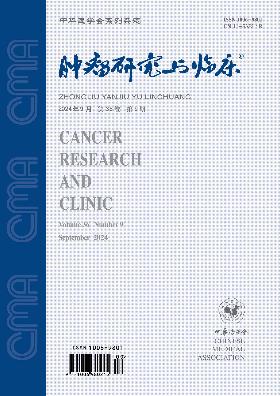Expression of epithelial-cadherin in triple negative breast cancer and its prognostic significance
Q4 Medicine
引用次数: 0
Abstract
Objective To investigate the expression of epithelial-cadherin (E-cad) in triple negative breast cancer (TNBC) and its effect on the prognosis of TNBC. Methods The data of 242 female patients with TNBC in Shanxi Provincial Cancer Hospital from April 2009 to April 2012 were collected. Immunohistochemical staining was used to detect the expression of E-cad. Kaplan-Meier method and Cox proportional hazard regression model were conducted to analyze the effect of E-cad on the prognosis of TNBC patients. Results The low expression rate of E-cad in TNBC patients was 59.5% (144/242) and its expression was related to clinical TNM stage and lymph node metastasis (both P < 0.05). The median overall survival time of 242 patients was 70.7 months (7.2-95.9 months), and 50 (20.7%) patients died. The 3-year and 5-year disease-free survival (DFS) rate was 81.5% and 78.1%, and the overall survival (OS) rate was 86.5% and 81.1%, respectively. The DFS and OS rate in the E-cad low expression group were lower than those in the E-cad high expression group, and the difference was statistically significant (both P < 0.01). Cox regression model demonstrated that E-cad was an independent prognostic factor of DFS and OS (HR=0.144, 95% CI 0.057-0.365, P < 0.01; HR=0.196, 95% CI 0.073-0.710, P < 0.01). Conclusion The low expression of E-cad is correlated with metastasis and the poor prognosis of TNBC, which could be an independent prognostic factor for TNBC patients. Key words: Cadherins; Breast neoplasms; Triple negative; Prognosis上皮钙粘蛋白在三阴性乳腺癌症中的表达及其预后意义
目的探讨上皮钙粘蛋白(E-cad)在癌症(TNBC)中的表达及其对TNBC预后的影响。方法收集山西省癌症医院2009年4月至2012年4月收治的242例女性TNBC患者的临床资料。免疫组化染色检测E-cad的表达。采用Kaplan-Meier方法和Cox比例风险回归模型分析E-cad对TNBC患者预后的影响。结果E-cad在TNBC患者中的低表达率为59.5%(144/242),其表达与临床TNM分期和淋巴结转移有关(均P<0.05),242例患者的中位总生存时间为70.7个月(7.2-95.9个月),50例(20.7%)患者死亡。3年和5年无病生存率(DFS)分别为81.5%和78.1%,总生存率(OS)分别为86.5%和81.1%。E-cad低表达组的DFS和OS率低于E-cad高表达组,Cox回归模型显示E-cad是DFS和OS的独立预后因素(HR=0.144,95%CI 0.057-0.365,P<0.01;HR=0.196,95%CI 0.073-0.710,P<0.01),这可能是TNBC患者的独立预后因素。关键词:Cadherins;乳腺肿瘤;三阴性;预后
本文章由计算机程序翻译,如有差异,请以英文原文为准。
求助全文
约1分钟内获得全文
求助全文
来源期刊

肿瘤研究与临床
Medicine-Oncology
CiteScore
0.10
自引率
0.00%
发文量
7737
期刊介绍:
"Cancer Research and Clinic" is a series of magazines of the Chinese Medical Association under the supervision of the National Health Commission and sponsored by the Chinese Medical Association.
It mainly reflects scientific research results and academic trends in the field of malignant tumors. The main columns include monographs, guidelines and consensus, standards and norms, treatises, short treatises, survey reports, reviews, clinical pathology (case) discussions, case reports, etc. The readers are middle- and senior-level medical staff engaged in basic research and clinical work on malignant tumors.
 求助内容:
求助内容: 应助结果提醒方式:
应助结果提醒方式:


